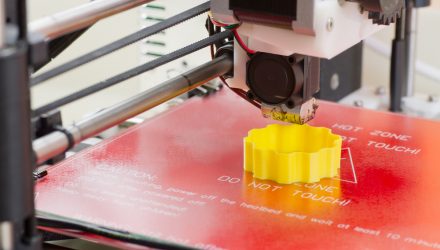The thesis for 3D printing assets and the 3D Printing ETF (CBOE: PRNT) is being reborn this year as growth forecasts for the industry paint a compelling long-term picture.
PRNT debuted nearly three years ago as the first US-listed ETF dedicated to the 3D printing theme. The fund is one of two passively managed products from New York-based Ark Investment Management. ARK believes 3D printing will revolutionize manufacturing by collapsing the time between design and production, reducing costs, and enabling greater design complexity, accuracy, and customization than traditional manufacturing.
“The global 3D printing market size was valued at USD 11.58 billion in 2019 and is expected to expand at a CAGR exceeding 14% from 2020 to 2027,” according to Trusted Business Insights. “Globally, 1.42 million units of 3D printers were shipped in 2018 and this number is expected to reach 8.04 million units by 2027.”
Plenty of Tailwinds
RNT’s underlying index index “is composed of equity securities and depositary receipts of exchange-listed companies from the U.S., non-U.S. developed markets and Taiwan that are engaged in 3D printing-related businesses within the following business lines: (i) 3D printing hardware, (ii) computer-aided design (“CAD”) and 3D printing simulation software, (iii) 3D printing centers, (iv) scanning and measurement, and (v) 3D printing materials,” according to Ark.
As regulatory guidelines become clearer, healthcare is expected to be a major market for 3D printing products and services in the years ahead and the same is true of other well-known industries.
“The aggressive R&D in Three-Dimensional Printing (3DP) and growing demand for prototyping applications from various industry verticals, particularly healthcare, automotive, and aerospace and defense, are the factors expected to drive the market growth,” according to TBI.
Healthcare, including dental, is one of many markets that could prove to be a potent catalyst for PRNT in the year ahead. Retail is another arena ripe for 3D printing disruption.
“3D printing benefits manufacturers in terms of prototyping, structural designing the structures and end products, modeling, and reduced time to market. As a result, the production expenses have reduced considerably helping the manufacturers offer better products at reasonable prices. As a result, the demand for 3D printers is expected to witness significant growth in the forthcoming years,” notes TBI.
For more on disruptive technologies, visit our Disruptive Technology Channel.
The opinions and forecasts expressed herein are solely those of Tom Lydon, and may not actually come to pass. Information on this site should not be used or construed as an offer to sell, a solicitation of an offer to buy, or a recommendation for any product.

